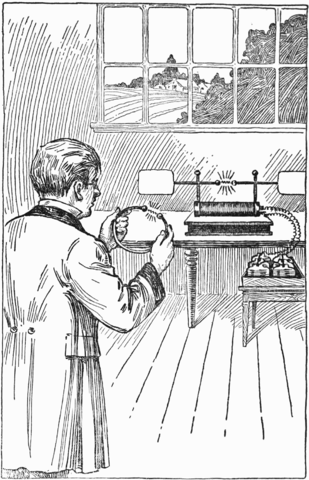(When I launched the Advent Calendar of Science Stories series back in December, I had a few things in mind, but wasn’t sure I’d get through 24 days. In the end, I had more than enough material, and in fact didn’t end up using a few of my original ideas. So I’ll do a few additional posts, on an occasional basis, to use up a bit more of the leftover bits from Eureka: Discovering Your Inner Scientist…)
One of the things I was reacting against in writing Eureka is the popular idea of scientists as a sort of unworldly elite, off doing their ivory-tower idealized thing without worrying about real-world concerns. In fact, science is an intensely human activity, and scientists are just as embedded in the real world as anybody else.
But then, sometimes, there is a bit of truth to the stereotypes…
One of the greatest experiments of the 19th century in physics was done by Heinrich Hertz in 1887. Hertz devoted most of his far too short career (he died of sudden illness at 36) to studying James Clerk Maxwell’s electromagnetic theory, confirming its various predictions about the induction of currents and the transmission of electromagnetic waves through free space.
The 1887 experiments are a beautiful piece of work. Hertz generated waves using a spark gap, which is pretty much what it sounds like– two electrodes with a gap of a centimeter or so between them. This was connected to a high-voltage oscillating circuit, which would generate a spark across the air gap at regular intervals. He detected the resulting waves with a smaller gap, a simple loop of wire with a small gap in it. The electric field of a passing wave produced by the original spark could induce a tiny visible spark in the receiver, which Hertz used to show the presence of fields emanating from the source. He also tested the strength of the field by varying the gap– bigger fields allow the generation of longer sparks.
Using this basic apparatus, he proved a whole bunch of Maxwell’s predictions– that waves were produced by the spark, that they were reflected by conductors but mostly unaffected by insulators. He also showed clearly that these were waves by generating standing waves and measuring the wavelength (I dimly remember a colloquium in grad school arguing that he was aided in this by the regularly spaced metal pillars in the hall where he did the experiment, but not more detail than that). Along the way, he incidentally discovered the photoelectric effect, from the observation that it was easier to generate sparks when there was a clear line of sight from the source spark to the receiver, allowing ultraviolet light to strike the receiver and knock loose some electrons. It’s a wonderful body of work, and the unit of frequency is named in his honor because of it.
The one thing Hertz lacked, though, was any kind of commercial instinct. Asked about the possible applications of his result, he famously replied:
It’s of no use whatsoever[…] this is just an experiment that proves Maestro Maxwell was right—we just have these mysterious electromagnetic waves that we cannot see with the naked eye. But they are there.
Within a decade, of course, a whole bunch of people had followed up Hertz’s experiments and Marconi and others had demonstrated wireless telegraphy, which would soon lead to the development of radio.
So, as much as I like to push back against the popular image of unworldly scientists, I have to admit, there’s some basis to it. Hertz was a brilliant experimental physicist, but no kind of businessman…
——
(“Featured image” cartoon from a 1922 book taken from this Wikimedia page.)

One thought on “Science Stories: Commercial Instincts”
Comments are closed.